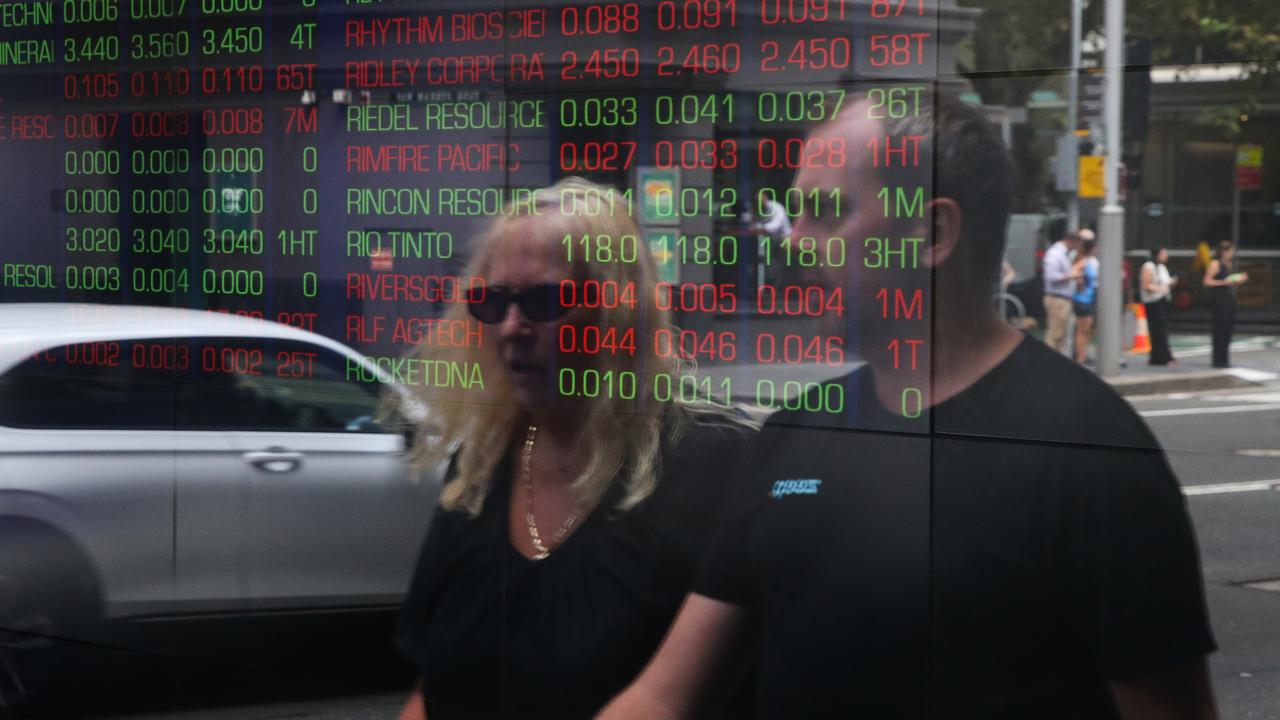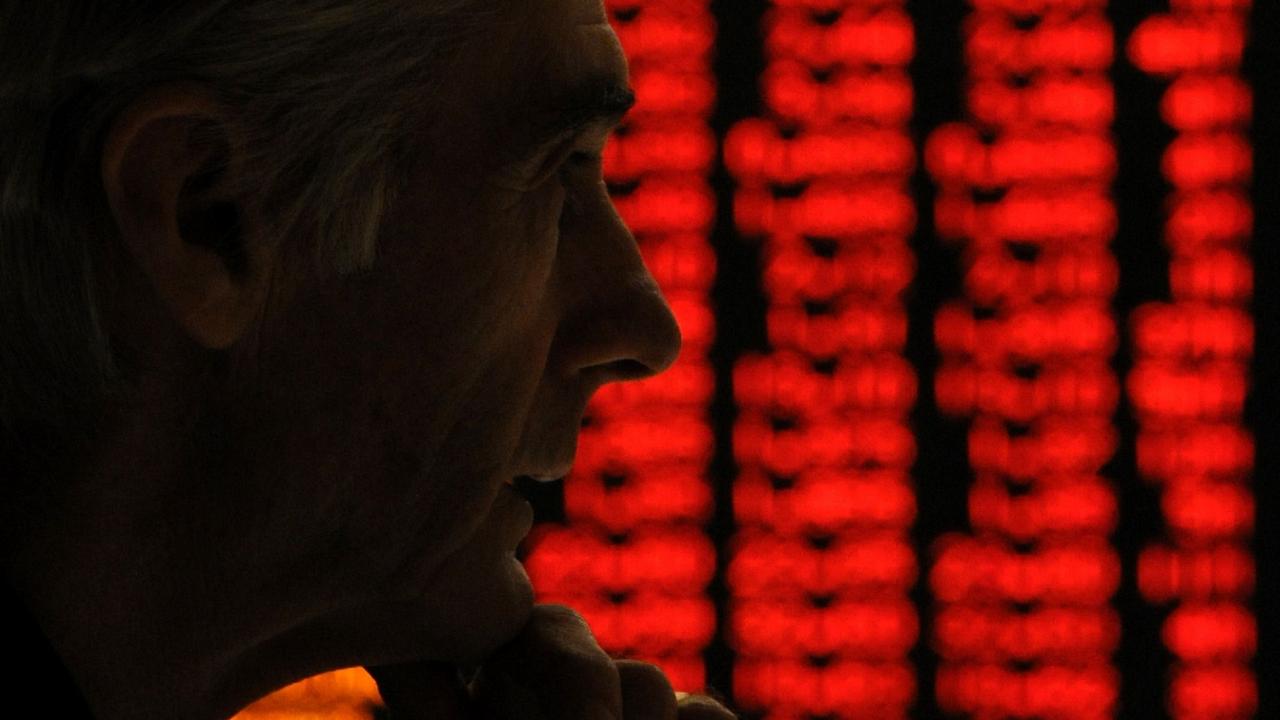Trading Day: live markets coverage, plus analysis and opinion
The local bourse has clawed its way to a positive close amid choppy trade, as bank strength offset falls among the miners.
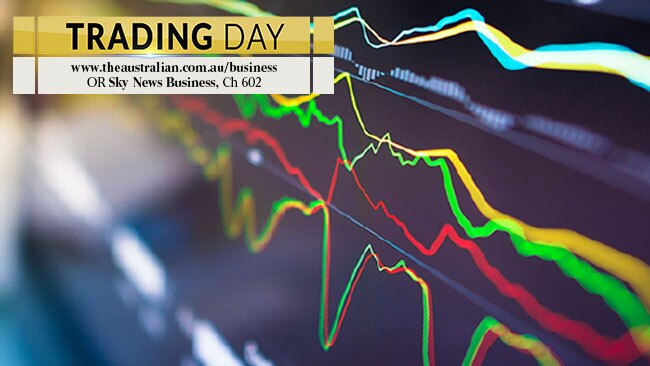
Welcome to Trading Day for Friday, September 22.
4.25pm: Stocks claw way to positive close
The Australian share market has broken a three-day losing streak as some buyers returned to the market despite negative overseas leads but trading volumes were lower than average.
At 16.15am (AEST), the benchmark S & P/ASX200 was up 26.7 points, or 0.47 per cent, at 5,682.1 points, while the broader All Ordinaries index was up 23.9 points, or 0.42 per cent, at 5,740.6 points.
AAP
2.55pm: Downgrade a mistake: China
China has lashed out at the decision by Standard & Poor’s to downgrade the country’s credit rating, calling the warning against ballooning debt “mistaken” and based on “cliches” about its economy.
The agency has slashed China from AA-minus to A-plus, a move that followed a similar decision in May by Moody’s stemming from concerns that the world’s second largest economy is increasingly overleveraged.
“Standard & Poor’s downgrade of China’s sovereign credit rating is a mistaken decision,” the finance ministry said in a statement, adding that the move was “perplexing.” It went on to scold the company for making a decision based on “cliches” about China’s economy.
The rating “ignores the unique characteristics of the capital raising structure of China’s financial markets”, it said.
“Most unfortunately, this is inertial thinking that international ratings agencies have held for a long time and is a misreading of China’s economy based on the experiences of developed countries,” the ministry said.
“This misreading also overlooks the good fundamentals and development potential of China’s economy.”
S & P followed the move today by cutting the top-notch credit rating of Hong Kong citing the city’s close links the mainland economy.
AFP
2.33pm: Domain split vote set for Nov. 2
Fairfax Media shareholders will receive one share in a newly listed Domain for every 10 Fairfax shares they own, if a vote to separate the real estate business from the news publisher is successful.
Fairfax (FXJ) shareholders will vote on the planned spin-off of Domain following the media company’s annual general meeting on November 2, with Domain expected to be listed on the ASX by the November 16, documents outlining the separation plan show.
Fairfax in August confirmed it will retain 60 per cent of the separately listed Domain, with Fairfax shareholders offered the remaining 40 per cent.
AAP
1.50pm: Oil strategy bears fruit
Oil-producing countries from inside and outside OPEC meet in Vienna tonight as signs grow that their landmark agreement to cap output may finally be boosting the price of crude.
Twenty-four producers including Russia, Saudi Arabia and Riyadh’s partners in OPEC agreed in late 2016 to reduce output by around 1.8 million barrels per day (bpd).
The deal, since extended to March 31, 2018, was aimed at reducing a global oil glut that had seen prices plummet from over $100 a barrel in 2014 to a 13-year low of under $US30 last year.
While good news for motorists and industries dependent on oil products, the low price hurt the finances even of rich Gulf countries, to say nothing of stricken OPEC member Venezuela.
Saudi Arabia for instance has withdrawn more than $US230 billion from its fiscal reserves since the end of 2014 and has forecast a budget deficit this year of $US53 billion.

The price of oil has seesawed considerably in the last six months, but this week traded around the $US50-per-barrel level after data suggested that the global glut is finally shrinking.
Officially, tonight’s meeting at the headquarters of the Organization of the Petroleum Exporting Countries of a six-nation monitoring committee is to review compliance with the accord.
But there is speculation that the gathering, including Russian Energy Minister Alexander Novak, might recommend that the deal be extended and even expanded.
AFP
1.00pm: Aussie dollar squeezed
The Aussie dollar remained below US80 cents at lunchtime, with lower iron ore prices, signals that a US interest rate hike was coming and yesterday’s speech by Reserve Bank of Australia governor Phillip Lowe converging to stifle the dollar’s recent upward run.
At 12.52pm (AEST) the local currency was at US79.24 cents, falling further after yesterday’s tumble, squeezed between Governor Lowe’s less hawkish commentary and the growing pressure from a stronger US dollar.
AAP
12:40pm: Stocks stay positive at noon
The Australian share market is trading in positive territory at lunchtime, after tumbling to a seven-month low in the previous session, as the local dollar comes under pressure.
The benchmark S & P/ASX200 index was ahead 0.2 per cent at noon (AEST), after bottoming out on Thursday to levels not seen since the beginning of the year. At noon on Friday, the local market was up slightly with losses in the energy, materials, industrials and healthcare sectors offset by gains in financials, telcos, utilities and property trusts.
A focus on rate rises coincided with a turnaround for the local big four banks with ANZ edging ahead by 0.3 per cent and, at the other end of the spectrum, Commonwealth bank rising one per cent.
Among the telcos, Telstra was up one per cent at $3.585, while Dodo-owner TPG Telecom was up 0.2 per cent at $5.05.
Following the announcement of a further $US2.5 billion share buyback, major miner Rio Tinto was ahead 0.9 per cent, at $66.10, while peer BHP Billiton was down 0.1 per cent, at $25.96, and iron-ore focused Fortescue Metals had shed 1.1 per cent, to $5.11, after the price of iron dropped $US3.50 to $US64.75 a tonne.
AAP
John Durie 12.05pm: Tatts-Tabcorp get gaming tick
Tabcorp and Tatts say they have received approvals from state and territory gambling regulators for their proposed $11 billion merger.
It comes as the proposed merger goes back to the Australian Competition Tribunal, following a court ruling. The tribunal earlier approved the tie-up but must look at it again, following a successful appeal by the ACCC.
However fresh doubts have emerged over the competition tribunal process, amid questions over its jurisdiction. (Read more)
11.20am: CBA’s ‘rational’ exit from insurance: UBS
Brokerage UBS labels CBA’s planned exit from life insurance business as a “rational strategic decision ... which should enable it to be more focused on its core banking businesses”.
UBS analyst Jonathan Mott notes life insurance contributed around 2 per cent of cash NPAT.
The comments follow CBA yesterday outlining plans to sell its CommInsure business to AIA for $3.8bn.
CBA will keep its general insurance and wealth management distribution operations.
The financial impact is largely immaterial.
UBS has also assumed CBA returns some of the capital via a buyback during financial 2019. UBS retains its “neutral” rating and a price target of $83 a share. CBA last traded at $76.65, up 58 cents.
11.10am: Stocks bounce after 7-month low
The Australian share market has rebounded and is solidly higher a day after hitting a seven-month low.
The benchmark S & P/ASX200 index was up 0.24 per cent at 5,669.2 points at 10.30am (AEST), with strength from the financials and telcos offsetting weakness across the energy and mining-related sectors.
The broader All Ordinaries index was up 10.3 points, or 0.18 per cent, at 5,727 points.
Phillip Capital senior client adviser Michael Heffernan said the share market was due for a rebound after three-straight days of losses that yesterday dragged the S & P/ASX200 index to 5,655.4 points, its lowest level since early February.
“We have been belted for most of this week and even last week. There had to be a rebound soon and that’s what we are seeing today,” Mr Heffernan said. “There is nothing overly negative to trigger another sell-off that the market hasn’t already priced in and in my view, yesterday’s US Federal Reserve’s monetary policy decision is a positive.
“Rates are going up and this shows the US economy is doing well.”
AAP
10.49am: Prime shares slump after talks fail
Shares in Prime Media sank over 7 per cent in early trade after it said talks with Seven West Media over a possible merger had failed to reach agreement.
Seven West said it was approached by its regional affiliate but that talks over a prospective deal — enabled by the scrapping of media ownership restrictions — were unproductive.
Prime said it “saw merit in a possible combination” but no agreement was reached and talks had ceased.
At 10.30am (AEST), shares in Prime were sharply lower, down 7.4 per cent. Seven West shares were up 0.35 per cent.
10.25am: ASX opens solidly higher
The Australian market has opened just under half a per cent higher, ignoring Wall Street’s negative performance.
At 10.15am (AEST), the benchmark S & P/ASX200 index was up 26.6 points, or 0.47 per cent, at 5,682.0, while the broader All Ordinaries index was up 23.5 points, or 0.41 per cent, at 5,740.2 points.
In futures trading, the SPI200 futures contract was up 23 points, or 0.41 per cent, at 5,665 points.
AAP
9.50am: More iron ore falls predicted
Iron ore’s 7.4 per cent price fall overnight to $US63 a tonne took the spot price to its lowest level since mid-July.
ANZ senior economist Daniel Gradwell says he expects prices to drop further, but stabilise around $US60 a tonne.
“The recent bear market in iron ore extended as supply concerns remained front of mind,” he said.

9.20am: Prime, Seven West talks falter
Seven West Media and regional broadcaster Prime Media have discussed a potential “marriage” but were unable to come to a suitable arrangement.
Prime says talks over “a possible combination of the two companies” ended, but neither firm gave the specifics of a prospective deal enabled by the scrapping of media ownership restrictions.
“While Prime saw merit in the possible combination, the parties were not able to agree on the terms of the transaction,” Prime (PRT) said in a statement to the ASX.
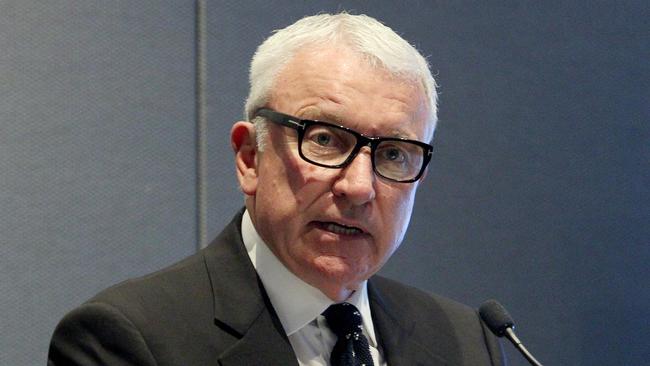
AAP
8.30am: Copper hits month low
Copper has hit its lowest in more than a month and nickel slid as much as six per cent after the Federal Reserve raised expectations of another US interest rate hike this year, boosting the dollar.
The Fed said yesterday it expected one more increase by the end of the year, driving the dollar to a two-month high versus the yen overnight and making dollar-priced metals costlier for non-US investors.
“The losses are mostly currency driven. The dollar was the main culprit behind the August gains so now to see a higher dollar is pounding all the metals,” said Gianclaudio Torlizzi, partner at metals consultancy T-Commodity. But he said copper prices could rise. “On the fundamental side demand is not booming (but) supplies have been reduced, so we don’t need such strong demand to put the metal in deficit,” he said.
Reuters
7.40am: ASX set to open higher
The Australian market looks set to open higher, ignoring the negative lead of international markets, especially Wall Street where the Dow and the S & P 500 broke their running streaks of record highs.
At 7am (AEST), the share price futures index was up 19 points, or 0.34 per cent, at 5,661.
In the US, stock indexes slipped as investors braced for a third official interest rate rise this year and the United States ordered new sanctions against North Korea.
The Dow Jones Industrial Average fell 0.24 per cent, the S & P 500 lost 0.30 per cent and the Nasdaq Composite dropped 0.52 per cent.
The Dow previously had attained fresh record highs for seven consecutive sessions and the S & P risen to record highs in six of the prior seven trading days.
Locally, no major economic or equities news is expected today. The Australian market yesterday fell for its third straight day, dropping nearly one per cent to its lowest level in more than seven months. The benchmark S & P/ASX200 index dropped 53.7 points, or 0.94 per cent, to 5,655.4 points.
The broader All Ordinaries index shed 53 points, or 0.92 per cent, to 5,716.7 points.
AAP
7.05am: Aussie dollar slips
The Australian dollar has again slipped against the US dollar which itself has fallen, losing some of its gains made on the Federal Open Markets Committee’s policy statement.
At 6.35am (AEST), the Australian dollar was worth US79.30 cents, down from US79.59 cents yesterday.
The Fed’s policy makers left rates unchanged, as anticipated, but the US central bank signalled there could be one more rate rise by year-end despite recent weak inflation readings.
Also, as expected, the Fed said it would begin in October to cut its roughly $US4.2 trillion in US Treasury bonds and mortgage-backed securities holdings by initially cutting up to $US10 billion each month from the amount of maturing securities it reinvests.
Westpac’s Imre Speizer says the Australian dollar had underperformed in the offshore session while the greenback also fell but the euro lifted and the pound outperformed.
“The US dollar shed some of yesterday’s FOMC-related gains, although interest rates remained elevated,” he said in a morning note.
“The US dollar index is down 0.3 per cent on the day. (The euro) EUR rose from 1.1870 to 1.1954. Outperformer GBP rose from 1.3470 to 1.3585 ...(while) underperformer AUD fell from 0.8000 to 0.7918. NZD ranged sideways between 0.7300 and 0.7335. AUD/NZD fell from 1.0900 to 1.0827.
He said he could see the local currency falling further.
“Momentum is starting to turn negative, targeting the 0.7900 area during the day ahead as long as the USD preserves some of its recent gains.”
The Aussie dollar is also lower against the yen and the euro.
AAP
7.00am: Iron ore slumps
The price of iron ore has taken another tumble, slumping 7.4 per cent to $US63.00, according to The Steel Index.
6.45am: US stocks end winning streak
Declines in shares of technology and consumer-staple stocks have ended major US indexes’ run of recent gains.
Some investors and analysts attributed the stall in the stock market to lingering uncertainty after the Federal Reserve suggested yesterday that it was open to the possibility of an interest-rate increase in December.
A streak of soft inflation data had made some investors sceptical the Fed would raise rates again in 2017. The fact that the central bank signalled otherwise caught some investors off guard, portfolio managers said.
“The market is sorting through to what extent it needs to incorporate future Fed activity into its thinking,” said Mike Allison, a portfolio manager with Eaton Vance. “There’s some uncertainty as to the impact since interest rates have been so low for so long.”
The Dow Jones Industrial Average slipped 53 points, or 0.2 per cent, to 22359, declining after nine consecutive sessions of advances. The S & P 500 slid 0.3 per cent, while the tech-heavy Nasdaq Composite fell 0.5 per cent.
Despite the US falls, Australian stocks are set to open higher. At 6.50am (AEST), the SPI futures index was up 18 points.
In the US, shares of consumer staple companies were among the S & P 500’s biggest decliners, falling 1 per cent in the broad index. Beauty products maker Coty fell 3.9 per cent, while Procter & Gamble fell 1.9 per cent.
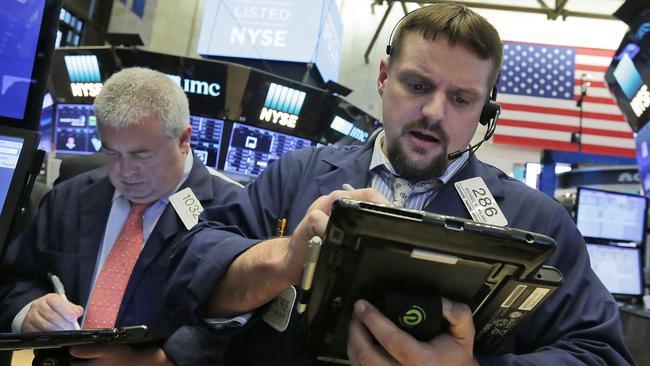
Technology stocks, among the best performers in the S & P 500 for 2017, also came under pressure. Shares of Apple fell 1.7 per cent, after the company acknowledged problems with cellular connectivity in its newest smartwatch.
Even with the declines, US stocks remained near their all-time highs. Some investors said they are now looking ahead to any policy developments in Washington that could provide further direction for the stock market.
Others say they will remain wary of the possibility of monetary policy hampering the stock rally.
Low interest rates have helped keep US stocks climbing since the financial crisis. A Fed that raises rates faster than the economy can support could cause the stock rally to stall, investors say.
Dow Jones
6.40am: Dollar slips against euro
The US dollar fell back against the euro but firmed against the yen, as markets assessed the Federal Reserve’s outlook for US interest rates.
The day before, the dollar had rallied against both main rivals and the Dow reached a fresh record high after the US central bank kept alive the chance of a December increase in American borrowing costs.
Fed chief Janet Yellen said the world’s biggest economy was “performing well”. It also emerged from the closely-watched meeting that most members of the policy board wanted to lift borrowing costs by December.
The central bank also announced it would next month begin cutting back on its holdings of bonds and other assets built up as part of a scheme to keep rates low and steer the economy through the global financial crisis a decade ago.
“The Federal Reserve’s intention to start shrinking its balance sheet in October and hike interest rates in December was positive for the US dollar,” said London Capital Group analyst Jasper Lawler.
“The glacially slow pace of the intended unwind of QE (quantitative easing) meant there were no ruffled feathers in stock markets,” the expert said.
“The prospect of QT (quantitative tightening) could mean markets are in the last gasps of a two week rally, but there is no sign of sentiment souring yet.” Accendo analyst Mike van Dulken agreed.
“Equities are taking the Fed’s latest policy tightening move in their stride. Probably because it was one of the most telegraphed moves ever, balanced up with the door being left ajar for another December hike ... No drama, just like the Fed (and markets) prefer.”
In Europe, shares in Germany’s second-largest lender Commerzbank leapt as rumours that the government might soon sell off its stake set financial circles abuzz.
London closed down 0.1 per cent, Frankfurt ended up 0.3 per cent and Paris closed 0.5 per cent higher.
AFP
6.30am: S & P lowers China’s credit rating
Standard & Poor’s has lowered China’s sovereign credit rating, joining a growing chorus of alarm over the nation’s soaring debt levels despite government pledges to fend off financial risks.
S & P Global Ratings last night downgraded China’s rating to A+ from AA-, while changing its outlook to stable from negative.
The action brings all the three major credit-rating firms in line in terms of their views of the creditworthiness of the world’s second-largest economy. Fitch Ratings lowered China’s rating in 2013, and Moody’s Investors Service did so in May.
The downgrade of China’s rating, the first such move by S & P since 1999, reflects its assessment that “a prolonged period of strong credit growth has increased China’s economic and financial risks”.
Dow Jones

